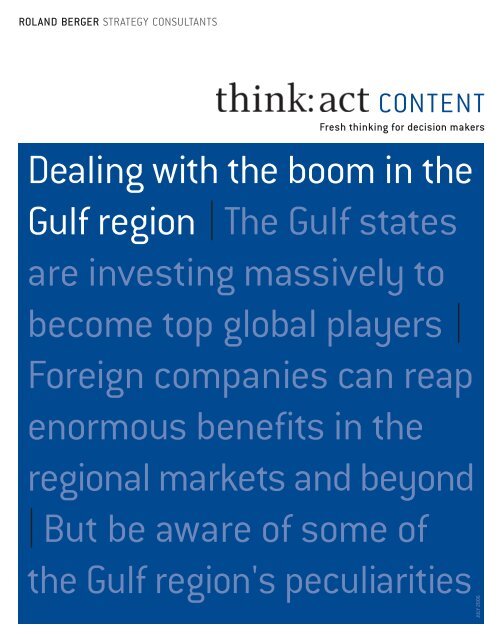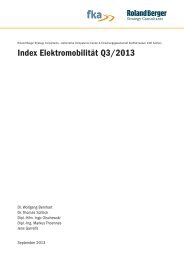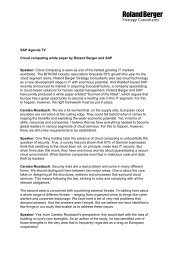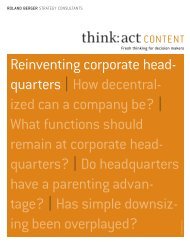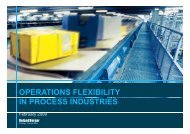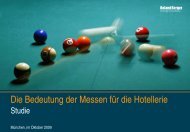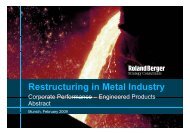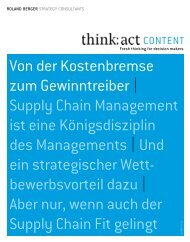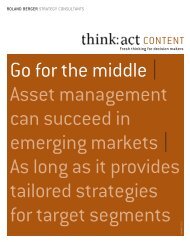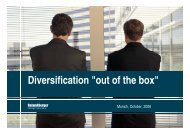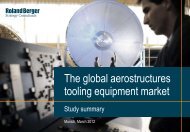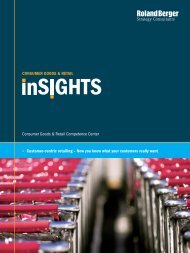Dealing with the boom in the Gulf region|The Gulf ... - Roland Berger
Dealing with the boom in the Gulf region|The Gulf ... - Roland Berger
Dealing with the boom in the Gulf region|The Gulf ... - Roland Berger
Create successful ePaper yourself
Turn your PDF publications into a flip-book with our unique Google optimized e-Paper software.
ROLAND BERGER STRATEGY CONSULTANTSCONTENTFresh th<strong>in</strong>k<strong>in</strong>g for decision makers<strong>Deal<strong>in</strong>g</strong> <strong>with</strong> <strong>the</strong> <strong>boom</strong> <strong>in</strong> <strong>the</strong><strong>Gulf</strong> region | The <strong>Gulf</strong> statesare <strong>in</strong>vest<strong>in</strong>g massively tobecome top global players |Foreign companies can reapenormous benefits <strong>in</strong> <strong>the</strong>regional markets and beyond| But be aware of some of<strong>the</strong> <strong>Gulf</strong> region's peculiaritiesJULY 2006
ROLAND BERGER STRATEGY CONSULTANTS[MEGA VISION] WHERE THE BILLIONS GOSelection of <strong>the</strong> largest mega-projects <strong>in</strong> <strong>the</strong> <strong>Gulf</strong> region,estimated <strong>in</strong>vestment amounts <strong>in</strong> USD33bn WORLD CENTRAL AIRPORT, DUBAIWorld's largest airport, <strong>in</strong>clud<strong>in</strong>g bus<strong>in</strong>ess and residential development<strong>with</strong> 750,000 <strong>in</strong>habitants. Airport will have comb<strong>in</strong>ed capacity ofLondon Heathrow and Chicago O'Hare, two of <strong>the</strong> world's busiest airports27bn KING ABDULLAH ECONOMIC CITY, SAUDI ARABIAEntirely new city <strong>with</strong> one of <strong>the</strong> world's biggest sea ports,expected to create 500,000 new jobs27bn BAWADI, DUBAI25World's largest hotel cha<strong>in</strong>, aim<strong>in</strong>g to double hotel capacity<strong>in</strong> Dubai by 2016 to 29,000 bedsbn PALMS, DUBAIThree waterfront developments resembl<strong>in</strong>g palm trees20 bn DOWNTOWN, DUBAI20 bn BUSINESS BAY, DUBAI15 bn AL RAHA BEACH, ABU DHABI15 bn BLUE CITY, OMANUrban development conta<strong>in</strong><strong>in</strong>g <strong>the</strong> world's largest malland <strong>the</strong> world's largest build<strong>in</strong>gDevelopment of an urban bus<strong>in</strong>ess freezone <strong>with</strong> hundreds of skyscrapersand <strong>the</strong> world's largest mar<strong>in</strong>aResidential and bus<strong>in</strong>ess area for over 120,000 <strong>in</strong>habitantsNew city for 250,000 people designed to attract 2 million tourists a year5bn TAWEELA SMELTER, ABU DHABIWorld’s largest alum<strong>in</strong>ium plant5bn PORT OF ARABIA, RAS AL KHAIMAHTourism and leisure facilities along 13 kilometers of coastl<strong>in</strong>e5bn LUSAIL, REAL ESTATE DEVELOPMENT IN QATARHous<strong>in</strong>g for 200,000 <strong>in</strong>habitants4 bn RAILWAY EXPANSION PROJECT, SAUDI ARABIAMore than 1,000 km of new railway tracks l<strong>in</strong>k<strong>in</strong>g <strong>the</strong> east and west coasts
CONTENTG ulf region <strong>boom</strong>“ WE HAVE TO MAKE HISTORY”The words “The world has a new center” adorn a gigantic construction site fence <strong>in</strong> <strong>the</strong> middleof Dubai. Beh<strong>in</strong>d <strong>the</strong> fence, Dubai Mall, slated to become <strong>the</strong> world’s largest shopp<strong>in</strong>g center,is tak<strong>in</strong>g shape. Meanwhile, Dubai World Central is <strong>the</strong> name earmarked for a major new airportthat is to handle around 120 million passengers a year by 2050 – <strong>the</strong> comb<strong>in</strong>ed capacityof London Heathrow and Chicago O'Hare.In announc<strong>in</strong>g <strong>the</strong> project for <strong>the</strong> new mega-airport, Dubai’s Prime M<strong>in</strong>ister, Sheik Mohammedb<strong>in</strong> Rashid al-Maktoum, leaves no room for doubt about his <strong>in</strong>tention to do great th<strong>in</strong>gs <strong>in</strong> hishome country: “We have to make history and approach <strong>the</strong> future <strong>with</strong> steady steps, not waitfor <strong>the</strong> future to come to us,” he declares.Al-Maktoum’s aim is to make his desert state <strong>the</strong> center of <strong>the</strong> modern world. And he is by nomeans alone. Barely a week passes by <strong>with</strong>out some country <strong>in</strong> <strong>the</strong> <strong>Gulf</strong> region announc<strong>in</strong>g yetano<strong>the</strong>r new mega-project. Right now, <strong>the</strong> countries that make up <strong>the</strong> <strong>Gulf</strong> Cooperation Council(GCC) – Bahra<strong>in</strong>, Kuwait, Oman, Qatar, Saudi Arabia and <strong>the</strong> United Arab Emirates – are <strong>in</strong>vest<strong>in</strong>gmore than USD 600 billion <strong>in</strong> total. Saudi Arabia, <strong>the</strong> biggest economy <strong>in</strong> <strong>the</strong> region, is mak<strong>in</strong>ghuge advances <strong>in</strong> its quest to become a global economic power. The “K<strong>in</strong>g Abdullah EconomicCity” project alone, for example, is supposed to generate 500,000 new jobs.As <strong>the</strong> people <strong>in</strong> charge have realized, however, this almost fairy-tale story of growth and successnow has to be placed on a susta<strong>in</strong>able foundation. Saeed al Muntafiq, CEO of <strong>the</strong> Tatweerdevelopment company, recently compared Dubai to a grow<strong>in</strong>g young lad: “It’s hungry, eatsseven meals a day, runs around for 17 hours a day bounc<strong>in</strong>g off <strong>the</strong> wall full of energy”.As this growth phase unfolds, tremendous opportunities are emerg<strong>in</strong>g for those foreign companiesthat astutely leverage <strong>the</strong> peculiarities of <strong>the</strong> widely vary<strong>in</strong>g markets <strong>in</strong> this region. Aseconomic development advances <strong>in</strong> leaps and bounds, <strong>the</strong> governments of <strong>the</strong> <strong>in</strong>dividual GCCstates have, <strong>in</strong> some cases, heralded a contest <strong>with</strong><strong>in</strong> <strong>the</strong> region. Noth<strong>in</strong>g less than <strong>the</strong> topglobal positions are <strong>the</strong> issue at stake.600USD 600 billion is <strong>the</strong> figure that experts believe <strong>the</strong>GCC states are pump<strong>in</strong>g <strong>in</strong>to <strong>in</strong>vestment projects600USD 600 billion is <strong>the</strong> estimated extra revenue thathigh oil prices brought <strong>in</strong>to GCC coffers <strong>in</strong> 2005/2006FINANCIAL SERVICES“One of <strong>the</strong> problems <strong>in</strong> <strong>the</strong> Middle East is that too much money is chas<strong>in</strong>gtoo few opportunities.” William Rhodes, Chairman, CitibankIn additon to <strong>the</strong> oil billions, a second wave of <strong>in</strong>vestment is flood<strong>in</strong>g <strong>the</strong> region. Internationalhotel cha<strong>in</strong>s, f<strong>in</strong>ancial <strong>in</strong>stitutions and <strong>in</strong>dustrial groups are digg<strong>in</strong>g ever deeper <strong>in</strong>to <strong>the</strong>irpockets to develop <strong>the</strong>se new economic hubs. In some markets such as Bahra<strong>in</strong>, however,<strong>in</strong>itial signs of an oversaturated f<strong>in</strong>ancial services market are already beg<strong>in</strong>n<strong>in</strong>g to show.Th<strong>in</strong> marg<strong>in</strong>s on major project f<strong>in</strong>ance po<strong>in</strong>t to cut-throat competition <strong>in</strong> all GCC markets.Some local banks have already <strong>with</strong>drawn from this bus<strong>in</strong>ess altoge<strong>the</strong>r.Given <strong>the</strong> ever greater diversification of <strong>the</strong>se economies, it is never<strong>the</strong>less obvious thatdemand for f<strong>in</strong>ancial services will cont<strong>in</strong>ue to <strong>in</strong>crease. Even <strong>the</strong> crash on <strong>the</strong> region’s stockmarkets <strong>in</strong> <strong>the</strong> first quarter of this year does noth<strong>in</strong>g to change this outlook. The only differenceis that exaggerated yield expectations have now given way to a keener <strong>in</strong>terest <strong>in</strong> professionalasset management. This goes <strong>in</strong> l<strong>in</strong>e <strong>with</strong> a fast-ris<strong>in</strong>g demand for sharia-compliantbank<strong>in</strong>g products, a field where GCC countries are already global market leaders.As <strong>the</strong>se still youthful capital markets cont<strong>in</strong>ue to develop, we see significant upside potential<strong>in</strong> <strong>the</strong> region. At <strong>the</strong> newly launched DIFX stock exchange <strong>in</strong> Dubai, for example, trad<strong>in</strong>gvolumes are still low and derivative products are hardly used at all.GLOBAL AMBITIONThe GCC countries aim to establish <strong>the</strong>mselvesas global hubs <strong>in</strong> several <strong>in</strong>dustriesEconomic activity:• F<strong>in</strong>ancial services• Aviation, trade, logistics• Tourism, healthcare, retail• Petrochemicals, heavy<strong>in</strong>dustryCountries:• Bahra<strong>in</strong>, Dubai,Qatar, Saudi Arabia• Dubai, Abu Dhabi• Dubai, Qatar, Oman• Saudi Arabia, Qatar,Abu Dhabi, Kuwait
ROLAND BERGER STRATEGY CONSULTANTSBANKING POWER2004 total bank<strong>in</strong>g assets growth of local banks <strong>in</strong>GCC countries and Europe (average of Euro zone,Denmark, Sweden, Switzerland and <strong>the</strong> UK), %UAEQatarSaudi ArabiaBahra<strong>in</strong>Oman 13,8Kuwait 1,8Europe6,8Sources: GCC central banks, European Bank<strong>in</strong>g FederationTAKE-OFFOrders for <strong>the</strong> new supersize Airbus A 380 jet,by countryS<strong>in</strong>gapore10Germany15Source: Airbus IndustriesFrance1022,720,920,219,5Australia12UAE47Bahra<strong>in</strong>’s position as a f<strong>in</strong>ancial center is fac<strong>in</strong>g <strong>in</strong>creas<strong>in</strong>gly stiff competition from its upand-com<strong>in</strong>grivals <strong>in</strong> Dubai and Qatar. All of which is creat<strong>in</strong>g positive conditions for foreignbanks. At <strong>the</strong> same time, Saudi Arabia, <strong>the</strong> region’s largest bank<strong>in</strong>g market, is open<strong>in</strong>g itsdoors to <strong>in</strong>ternational players.The private equity market too is flourish<strong>in</strong>g rapidly. Between 2004 and 2005, <strong>the</strong> value ofGCC private equity funds surged from USD 3.8 billion to USD 6.0 billion, <strong>the</strong> majority of whichis <strong>in</strong>vested outside <strong>the</strong> <strong>Gulf</strong> region. This development aga<strong>in</strong> <strong>in</strong>dicates that demand for <strong>the</strong>services of <strong>in</strong>vestment banks and auditors will rise sharply <strong>in</strong> future.AVIATION, TRADE AND LOGISTICS“We have four billion people <strong>with</strong><strong>in</strong> eight hours of fly<strong>in</strong>g time from Dubai, and <strong>the</strong>y’rebecom<strong>in</strong>g very active.” Tim Clark, President, Emirates GroupTen years ago, people laughed <strong>in</strong> disbelief when planners said Dubai International Airportwould be handl<strong>in</strong>g 25 million passengers a year by 2005. No-one is laugh<strong>in</strong>g now that <strong>the</strong>target has been reached, though. Over <strong>the</strong> next six years, this figure is projected to explodeto 70 million passengers a year. This will only be possible if Dubai rema<strong>in</strong>s <strong>the</strong> hub of trafficbetween <strong>the</strong> Western world and <strong>the</strong> <strong>boom</strong> regions of Asia. And whe<strong>the</strong>r that happensdepends on two factors. First, <strong>the</strong> governments of India and Ch<strong>in</strong>a must ma<strong>in</strong>ta<strong>in</strong> <strong>the</strong>irrestrictive stance on direct flights. Second, competitors such as Air India must rema<strong>in</strong>unable to cope <strong>with</strong> <strong>the</strong> masses of customers <strong>the</strong>y face <strong>in</strong> <strong>the</strong>ir home countries.Dubai has no <strong>in</strong>tention of rely<strong>in</strong>g solely on vast passenger and freight handl<strong>in</strong>g capacity,however. The Dubai Aerospace Center mega-project (be<strong>in</strong>g built at a cost of USD 15 billion)is also hugely ramp<strong>in</strong>g up <strong>the</strong> airl<strong>in</strong>e services segment. Everyth<strong>in</strong>g from aircraft leas<strong>in</strong>gand ma<strong>in</strong>tenance to <strong>the</strong> tra<strong>in</strong><strong>in</strong>g of area specialists and aircraft eng<strong>in</strong>eers at a dedicateduniversity will be on offer here when <strong>the</strong> project is completed.Incumbents such as Emirates and Qatar Airways are <strong>in</strong>vest<strong>in</strong>g heavily <strong>in</strong> <strong>the</strong>ir fleets <strong>in</strong>anticipation of fierce predatory competition. Meanwhile, <strong>the</strong> market for low-cost carriersconstitutes a fur<strong>the</strong>r highly attractive segment. Start-up Air Arabia (based <strong>in</strong> <strong>the</strong> emirate ofSharjah) broke even after only 12 months <strong>in</strong> bus<strong>in</strong>ess, for example, and welcomed its millionthpassenger on board six months later.The significance of <strong>the</strong> Middle East to world trade is also grow<strong>in</strong>g constantly. The volume ofgoods traded <strong>with</strong> Asia alone nearly doubled to a total volume of USD 300 million between2002 and 2005. Accord<strong>in</strong>g to recent figures, <strong>the</strong> port of Dubai ranks n<strong>in</strong>th worldwide. Ithas more than doubled its conta<strong>in</strong>er traffic s<strong>in</strong>ce 2001. Strong growth is also expected fortrade <strong>with</strong> Europe. Statements by both parties suggest that <strong>the</strong> EU and <strong>the</strong> GCC will verysoon sign a free-trade agreement. Moreover, if all <strong>the</strong> region’s port projects are <strong>in</strong>deed realized<strong>in</strong> <strong>the</strong> years ahead, <strong>the</strong> <strong>Gulf</strong> region has <strong>the</strong> potential to become both <strong>the</strong> world’s numberone passenger hub and its lead<strong>in</strong>g transshipment hub.Logistics companies based <strong>in</strong> Kuwait have benefited especially handsomely from <strong>the</strong>irfavorable location <strong>in</strong> recent years. Many of <strong>the</strong> supplies channeled <strong>in</strong>to Iraq pass throughthis t<strong>in</strong>y country. Companies such as PWC Logistics have seized <strong>the</strong> opportunity to crafthighly successful bus<strong>in</strong>ess models. An <strong>in</strong>dependent supply cha<strong>in</strong>, cutt<strong>in</strong>g-edge IT and lowfuel and personnel costs enable <strong>the</strong> firm to operate at a profit even <strong>in</strong> high-risk areas <strong>with</strong>poor <strong>in</strong>frastructures. By consequence, <strong>the</strong> company is fur<strong>the</strong>r improv<strong>in</strong>g its market position<strong>in</strong> <strong>boom</strong> regions such as India.
CONTENTG ulf region <strong>boom</strong>TOURISM, HEALTHCARE, RETAIL“We can’t just keep build<strong>in</strong>g hotels and shopp<strong>in</strong>g malls and depend on sun and sand.We have to move <strong>in</strong> o<strong>the</strong>r directions.” Salem b<strong>in</strong> Dasmal, CEO, DubailandDubai is by no means <strong>the</strong> only one that is successfully ramp<strong>in</strong>g up its commitment to <strong>the</strong>blossom<strong>in</strong>g tourism <strong>in</strong>dustry. European visitors <strong>in</strong> particular <strong>in</strong>creas<strong>in</strong>gly regard Oman as aluxury dest<strong>in</strong>ation that comb<strong>in</strong>es oriental charm <strong>with</strong> political stability. Meanwhile, Qatarhas made a name for itself <strong>in</strong> <strong>the</strong> bus<strong>in</strong>ess and event tourism segment <strong>with</strong> high-level conferencesand sport<strong>in</strong>g events.One factor that currently <strong>in</strong>hibits growth <strong>in</strong> <strong>the</strong> tourism <strong>in</strong>dustry is hotel capacity. Bed occupancy<strong>in</strong> <strong>the</strong> GCC states is considerably higher than <strong>in</strong> <strong>the</strong> Western world. It never<strong>the</strong>lessrema<strong>in</strong>s to be seen whe<strong>the</strong>r <strong>the</strong> market will accept exist<strong>in</strong>g and planned leisure offer<strong>in</strong>gs,from ski pistes to a Ferrari <strong>the</strong>me park. A grow<strong>in</strong>g downside risk <strong>in</strong> <strong>the</strong> region is that <strong>the</strong><strong>boom</strong> could negatively impact visitors’ vacation experience. Dubai’s pr<strong>in</strong>cipal traffic routesever more frequently suffer from congestion. And <strong>in</strong>creas<strong>in</strong>g numbers of property developersare compla<strong>in</strong><strong>in</strong>g that power and water supply l<strong>in</strong>es are not ready on time.At <strong>the</strong> same time, <strong>the</strong> region’s voracious appetite for <strong>in</strong>frastructure is open<strong>in</strong>g up tremendousopportunities for foreign firms. Water utilities are a case <strong>in</strong> po<strong>in</strong>t. Between now and 2020, <strong>the</strong>Saudi Arabian government plans to <strong>in</strong>vest USD 150 billion dollars to deal <strong>with</strong> this problem alone.Healthcare is ano<strong>the</strong>r particularly important growth market <strong>in</strong> <strong>the</strong> region. S<strong>in</strong>ce 9/11 and <strong>the</strong>Iraq war, it has become less attractive for wealthy Arabs to travel to <strong>the</strong> USA for medical treatment.The aim now is to transfer US healthcare standards - one example is a collaborativeventure <strong>with</strong> Harvard University <strong>in</strong> relation to <strong>the</strong> development of Health Care City <strong>in</strong> Dubai.The retail <strong>in</strong>dustry too is enjoy<strong>in</strong>g a very favorable situation. Low logistics costs, low wagesand attractive <strong>in</strong>put prices (due to low taxes) offer cost benefits to retailers <strong>in</strong> <strong>the</strong> region.Well-appo<strong>in</strong>ted store space <strong>in</strong> large malls and a propensity to consume on a par <strong>with</strong> that of<strong>the</strong> USA are also do<strong>in</strong>g <strong>the</strong>ir bit to drive up profits. Collaboration <strong>with</strong> very successful localcompanies is <strong>the</strong> obvious po<strong>in</strong>t of entry. M.H. Alshaya Company, for example, operatesaround 1,000 franchise stores <strong>in</strong> <strong>the</strong> region – <strong>in</strong>clud<strong>in</strong>g <strong>the</strong> most profitable Starbucks outlets<strong>in</strong> <strong>the</strong> world, accord<strong>in</strong>g to <strong>in</strong>dustry <strong>in</strong>siders.FULLY BOOKED2005 hotel room occupancy <strong>in</strong> GCC countriesand Europe, as % of total capacityUAE81.9Qatar74.9Bahra<strong>in</strong>71Oman70.1Kuwait69.7Europe65.1Saudi Arabia57.9Source: DeloittePETROCHEMICALS/HEAVY INDUSTRY“It’s a great place for alum<strong>in</strong>um producers to be.” Cynthia Carroll, President, AlcanA favorable geostrategic position between Europe and <strong>the</strong> Far East comb<strong>in</strong>ed <strong>with</strong> vast oil andgas reserves gives <strong>the</strong> GCC states a natural advantage. Low labor costs fur<strong>the</strong>r enhance <strong>the</strong>region’s benefits. Saudi Arabia <strong>in</strong> particular has built up huge capacity <strong>in</strong> <strong>the</strong> petrochemicals<strong>in</strong>dustry. By 2015 <strong>the</strong> Saudi Basic Industry Corporation (Sabic) aims to corner a dom<strong>in</strong>ant15% share of <strong>the</strong> global petrochemicals market.In <strong>the</strong> most energy-<strong>in</strong>tensive <strong>in</strong>dustry sectors, <strong>the</strong> GCC states benefit twice over from highenergy prices. They can sell oil and gas at exorbitant rates while still supply<strong>in</strong>g <strong>the</strong>ir own factories<strong>with</strong> low-cost energy. This is especially true of alum<strong>in</strong>um production, where energyaccounts for around one third of total costs. On this front, Qatar and Abu Dhabi <strong>in</strong> particular<strong>in</strong>tend to adopt an aggressive stance on <strong>the</strong> global market as soon as <strong>the</strong>ir planned alum<strong>in</strong>umsmelters – <strong>the</strong> largest <strong>in</strong> <strong>the</strong> world – go <strong>in</strong>to operation. Abu Dhabi’s steel <strong>in</strong>dustry toohas plans to build a plant <strong>with</strong> capacity of 2 million tons per annum and will play a muchmore active role <strong>in</strong> future.7million tons p.a.Saudi Arabia is <strong>in</strong> a tight contest <strong>with</strong> Ch<strong>in</strong>a forthird place <strong>in</strong> <strong>the</strong> global rank<strong>in</strong>g of petrochemicalproducers, based on capacity to produce ethylene,<strong>the</strong> build<strong>in</strong>g block of <strong>the</strong> <strong>in</strong>dustry. USA ranks first,Japan second.Source: Economist Intelligence Unit
ROLAND BERGER STRATEGY CONSULTANTSSAUDI ARABIAGDP: USD 307.7 bn Real GDP growth: 6,5%Population: 24.6 m GDP per capita: USD 12,500UNITED ARAB EMIRATESGDP: USD 119,5 bn Real GDP growth: 6.7%Population: 4.7 m GDP per capita: USD 25,400KUWAITGDP: USD 70.5 bn Real GDP growth: 8.1 %Population: 3.0 m GDP per capita: USD 23,500QATARGDP: USD 35.4 bn Real GDP growth: 8.8%Population: 0.9 m GDP per capita: USD 39,300COUNTRY SPECIFICSThe GCC states have a strong sense of political solidarity and face several similar challenges.These <strong>in</strong>clude a young population (ca. 50% under <strong>the</strong> age of 20) that will eventually needemployment. In some countries, governments have responded <strong>with</strong> labor force nationalizationprograms that aim to reduce local unemployment and <strong>the</strong> dependency on expatriates. Despitesome similarities, <strong>the</strong> GCC states are a very varied assortment. And some of <strong>the</strong>ir differencesconcern critical factors. Toge<strong>the</strong>r <strong>with</strong> <strong>the</strong> experts from <strong>the</strong> Economist Intelligence Unit, wehave compiled a brief overview.[SAUDI ARABIA] In 2006, Saudi Arabia’s export earn<strong>in</strong>gs are forecast to reach USD209.1billion– <strong>the</strong> highest level of receipts that <strong>the</strong> k<strong>in</strong>gdom has ever generated. The authorities arecont<strong>in</strong>u<strong>in</strong>g cautious moves towards economic reform, <strong>with</strong> <strong>the</strong> emphasis on boost<strong>in</strong>g <strong>the</strong> paceof growth <strong>in</strong> <strong>the</strong> non-oil sector. Non-oil exports have begun to grow as government-led effortsto diversify <strong>the</strong> economy have taken effect. Aside from petrochemicals, which account for <strong>the</strong>bulk of <strong>the</strong>se exports, grow<strong>in</strong>g <strong>in</strong>dustries <strong>in</strong>clude manufactur<strong>in</strong>g and metals exports.Follow<strong>in</strong>g successful measures to overhaul <strong>the</strong> telecommunications <strong>in</strong>dustry, additionalparts of <strong>the</strong> economy will be opened up to private-sector competition. The pace of economicreform, however, is hampered by <strong>in</strong>stitutional and political resistance, <strong>with</strong> even small measuresrequir<strong>in</strong>g a consensus among senior members of <strong>the</strong> rul<strong>in</strong>g elite – someth<strong>in</strong>g that isoften difficult to achieve given <strong>the</strong> vested <strong>in</strong>terests <strong>in</strong>volved.The recent accession of Saudi Arabia to <strong>the</strong> World Trade Organization means that <strong>the</strong> governmentis mandated to provide foreign <strong>in</strong>vestors <strong>with</strong> additional opportunities, particularly topartner <strong>in</strong> large-scale <strong>in</strong>frastructure <strong>in</strong>vestment. For example, <strong>the</strong> government is look<strong>in</strong>g forprivate <strong>in</strong>vestors to foot a large part of <strong>the</strong> bill for its hugely ambitious railway project.[UNITED ARAB EMIRATES] The government cont<strong>in</strong>ues to promote a progressive economicagenda. Steps are be<strong>in</strong>g taken to foster fur<strong>the</strong>r foreign <strong>in</strong>vestment, <strong>in</strong>clud<strong>in</strong>g <strong>the</strong> abolition of<strong>the</strong> sole agency law and regulations that restrict foreigners to m<strong>in</strong>ority stakes <strong>in</strong> local firms.Fur<strong>the</strong>r evidence of this shift towards a more liberal approach comes from <strong>the</strong> recent issu<strong>in</strong>gof a decree allow<strong>in</strong>g foreigners to own property on a freehold basis <strong>in</strong> designated areas.The emirate of Dubai rema<strong>in</strong>s at <strong>the</strong> forefront of economic reform and development, and isbuild<strong>in</strong>g on its emerg<strong>in</strong>g position as <strong>the</strong> region’s services hub as well as fur<strong>the</strong>r growth <strong>in</strong> itsexist<strong>in</strong>g manufactur<strong>in</strong>g and <strong>in</strong>dustrial base. Abu Dhabi, meanwhile, cont<strong>in</strong>ues to <strong>in</strong>vest heavily<strong>in</strong> <strong>the</strong> development of its large upstream hydrocarbons resources and downstream <strong>in</strong>dustrialprojects, notably <strong>in</strong> <strong>the</strong> petrochemicals sector. Longstand<strong>in</strong>g concerns, however, that <strong>the</strong>domestic economy may be overheat<strong>in</strong>g and that asset prices <strong>in</strong> particular had reachedunmerited and unsusta<strong>in</strong>able levels were realized <strong>with</strong> a dramatic downturn <strong>in</strong> equity pricesearlier this year. Inflation is also a major concern. Never<strong>the</strong>less, <strong>the</strong> economy is well-placedto ride out <strong>the</strong> downturn, <strong>with</strong> high oil prices, strong <strong>in</strong>vestment and low real <strong>in</strong>terest ratesset to ensure that <strong>the</strong>re rema<strong>in</strong>s significant momentum <strong>with</strong><strong>in</strong> <strong>the</strong> local economy.[KUWAIT] While o<strong>the</strong>r GCC countries are embrac<strong>in</strong>g foreign <strong>in</strong>vestment, <strong>the</strong> pace of economicreform <strong>in</strong> Kuwait is considerably more cautious. The government has made strongcommitments to large <strong>in</strong>frastructure projects, but <strong>the</strong>se are liable to be state-led. ProjectKuwait, a long-stand<strong>in</strong>g economic reform proposal to <strong>in</strong>troduce foreign <strong>in</strong>vestment <strong>in</strong>to fournor<strong>the</strong>rn oilfields, cont<strong>in</strong>ues to attract vehement opposition from some members of <strong>the</strong>
CONTENTG ulf region <strong>boom</strong>government, and <strong>the</strong> proposals have yet to be approved. Despite <strong>the</strong> welter of public <strong>in</strong>frastructureprojects that have been approved <strong>in</strong> recent years, <strong>in</strong>volvement from <strong>the</strong> privatesector rema<strong>in</strong>s limited, o<strong>the</strong>r than <strong>in</strong> a contracted service capacity. There is also little <strong>in</strong> <strong>the</strong>way of diversification outside of <strong>the</strong> energy sector, and <strong>the</strong> IMF has urged <strong>the</strong> governmentto bolster <strong>in</strong>vestment <strong>in</strong> non-oil <strong>in</strong>dustries. While such <strong>in</strong>vestments rema<strong>in</strong> few, <strong>the</strong> countrydoes have a strong track record <strong>in</strong> amass<strong>in</strong>g large stocks of foreign assets, <strong>with</strong> dedicatedgovernment agencies manag<strong>in</strong>g portfolios f<strong>in</strong>anced by surplus oil revenue. Their assets arethought to be worth several hundred billion dollars.[QATAR] Economic growth <strong>in</strong> Qatar is forecast to be among <strong>the</strong> highest <strong>in</strong> <strong>the</strong> region, <strong>with</strong>real GDP growth reach<strong>in</strong>g 7.9% <strong>in</strong> 2006 and <strong>in</strong>creas<strong>in</strong>g to 8.9% <strong>in</strong> 2007. Developments <strong>in</strong> <strong>the</strong>energy sector will be <strong>the</strong> ma<strong>in</strong> contributor to growth. In early 2006, Qatar overtook Indonesiaas <strong>the</strong> world’s largest exporter of liquefied natural gas (LNG) – a position that will be bolstered<strong>in</strong> <strong>the</strong> com<strong>in</strong>g years. At <strong>the</strong> same time, <strong>the</strong> government has been seek<strong>in</strong>g to encourageprivate and foreign <strong>in</strong>vestment <strong>in</strong>to non-energy sectors. In May 2005, <strong>the</strong> Qatar F<strong>in</strong>ancialCentre was <strong>in</strong>augurated. as part of an effort to create a national centre for major f<strong>in</strong>ance<strong>in</strong>stitutions. Although it faces stiff competition from Dubai and Bahra<strong>in</strong>, <strong>the</strong> hope is that Qatarwill attract foreign capital and serve as a regional f<strong>in</strong>ancial hub l<strong>in</strong>k<strong>in</strong>g Asia and Europe.In addition, <strong>the</strong> government has announced plans to set up several free trade zones, <strong>with</strong> <strong>the</strong>aim of encourag<strong>in</strong>g fur<strong>the</strong>r diversification outside of <strong>the</strong> energy sector. With a new <strong>in</strong>vestmentlaw planned, and <strong>the</strong> region cont<strong>in</strong>u<strong>in</strong>g to benefit from record oil prices, Qatar appearswell placed to improve on its previously poor performance <strong>in</strong> attract<strong>in</strong>g foreign <strong>in</strong>vestment<strong>in</strong>to non-energy-related sectors.[OMAN] The need to meet <strong>the</strong> challenge of demographic change is encourag<strong>in</strong>g <strong>the</strong> Omanigovernment to press ahead <strong>with</strong> a substantive program of economic reform. Increased participationof <strong>the</strong> private sectors <strong>in</strong> <strong>in</strong>frastructure provision such as telecommunication isplanned. While <strong>the</strong>re are opportunities for foreign direct <strong>in</strong>vestment <strong>in</strong> Oman, <strong>the</strong> reality on<strong>the</strong> ground can be complex. In October 2004, a consortium of private companies set up tomanage Oman’s two airports collapsed just two years after be<strong>in</strong>g awarded a 25-year contract.Management of <strong>the</strong> airports has s<strong>in</strong>ce been returned to state hands.O<strong>the</strong>r moves towards economic reform will concentrate pr<strong>in</strong>cipally on diversify<strong>in</strong>g <strong>the</strong> economy.Beyond hydrocarbons, prospects for <strong>the</strong> services sector are strong, <strong>with</strong> <strong>the</strong> expansionof a conta<strong>in</strong>er port at Salalah and an <strong>in</strong>dustrial zone at Sohar set to cont<strong>in</strong>ue. Tourism is alsoa grow<strong>in</strong>g sector, <strong>with</strong> several major new ventures already underway.[BAHRAIN] Bahra<strong>in</strong> is considered <strong>the</strong> freest economy <strong>in</strong> <strong>the</strong> Middle East accord<strong>in</strong>g to <strong>the</strong>2006 world economic freedom <strong>in</strong>dex published by <strong>the</strong> Heritage Foundation/Wall Street Journal.And <strong>the</strong> Bahra<strong>in</strong>i government is expected to still press ahead <strong>with</strong> its liberalization program,which should promote more rapid <strong>in</strong>flows of foreign <strong>in</strong>vestment. Although Bahra<strong>in</strong> has benefitedfrom high oil prices, its reliance on high import volumes to feed large-scale developmentprojects, such as <strong>the</strong> upgrade of Bahra<strong>in</strong> Petroleum Company and <strong>the</strong> development of Bahra<strong>in</strong>F<strong>in</strong>ancial Harbor, will restra<strong>in</strong> <strong>the</strong> impact of consumption and <strong>in</strong>vestment on overall expansion.Much like <strong>the</strong> o<strong>the</strong>r GCC countries, Bahra<strong>in</strong> faces <strong>the</strong> challenge of f<strong>in</strong>d<strong>in</strong>g employment for itsrapidly grow<strong>in</strong>g young adult population. The country´s development efforts are very muchgeared towards labor market reform, to <strong>in</strong>duce <strong>the</strong> replace of foreign workers <strong>with</strong> locals.OMANGDP: USD 29.6 bn Real GDP growth: 5.6%Population: 2.5 m GDP per capita: USD 11,800BAHRAINGDP: USD 13.2 bn Real GDP growth: 5.9%Population: 0.7 m GDP per capita: USD 14,700All Data from 2005Source: Economist Intelligence UnitDO YOU HAVE ANY QUESTIONS OR COMMENTS?PLEASE FEEL FREE TO CONTACT US:Michael WettePartner and Manag<strong>in</strong>g Director<strong>Roland</strong> <strong>Berger</strong> Middle EastAlmoayyed Tower, 21 st floorP. O .B ox: 18259Manama - K<strong>in</strong>gdom of Bahra<strong>in</strong>+973 (17) 567-951Michael_Wette@bh.rolandberger.comth<strong>in</strong>k:act CONTENTPublishers: Burkhard Schwenker, António BernardoOverall responsibility: Torsten OltmannsProject management: Carsten MatthäusContributors to this issue: Economist Intelligence Unit<strong>Roland</strong> <strong>Berger</strong> Strategy ConsultantsStadthausbrücke 720355 Hamburg+49(40) 37631-0news@rolandberger.com


